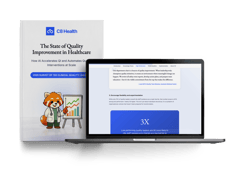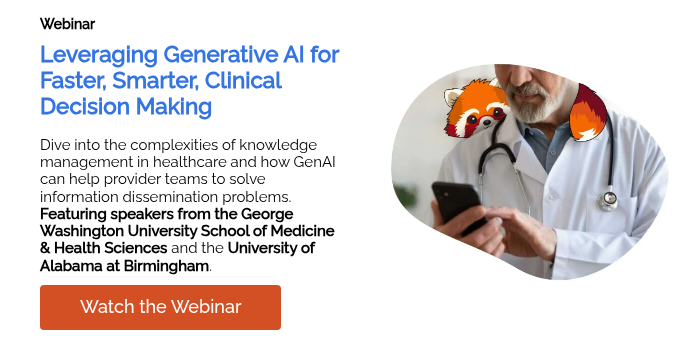
Automated Workflows: Transforming Clinical Best Practices
Automated workflows support healthcare professionals by doing routine tasks, reducing mistakes, and saving time. Inefficient workflows are a pervasive problem in healthcare. So the timesaving that automation offers is key in a sector where quick and accurate decisions can be life-saving.
These systems give healthcare workers useful information based on data, not just memory or outdated practices. This means they can make better decisions, faster. And in healthcare, that can sometimes mean the difference between life and death.
» Looking to improve morale? Here's how to keep healthcare staff happy and productive.
Meet the expert
Mical DeBrow is an accomplished healthcare leader and clinician with extensive expertise spanning pharma, healthcare payers and providers, and healthcare information technology.
What Are Automated Workflows in Healthcare?
Automated workflows use technology to streamline repetitive and manual healthcare tasks, freeing up time and resources for what matters most: patient care.
In a clinical context, this could extend from administration, like automating notifications about lab test results to patients and clinicians and appointment scheduling, to surgical practice such as automated high-precision surgery.
These automations ensure systematic organization and completion of tasks, and inform all relevant stakeholders-patients, clinicians, and administrators-through notifications.
Benefits of Automated Workflows in Healthcare
In modern healthcare systems, automated workflows make processes more efficient and reduce the risk of errors. By automating workflows, healthcare professionals can focus on delivering high-quality healthcare services.
Automated workflows can also ping alerts to guide workers on the subsequent tasks and give guidance on carrying them out. This helps ensure healthcare facilities boost worker productivity and patient care.
Efficiency in Patient Diagnosis and Treatment
Automated workflows can play a role in diagnostics. For example, cardiology has new diagnostic workflows that collect appropriate data at the right time for quicker, more accurate diagnoses.
By bringing together data such as imaging, electronic cardiograph tracings, and lab values in real-time, it is now easier to identify diseases like cardiac rhythm disturbances, cardiac failure, and cardiac valve disease.
Automated workflows have also significantly impacted the field of AI-assisted robotic surgery. These systems provide high precision beyond human capability, resulting in better surgical outcomes.
To better understand how AI is helping clinicians achieve better patient outcomes, watch our latest webinar.
Automated Reminders and Decision Support Systems
Automated reminders and decision support systems are essential elements of these workflows. They are "gentle reminders" to healthcare providers to adhere to science-based practices.
Although some physicians may feel overwhelmed by alerts and notifications, these AI features are designed to support them, not replace their expertise.
Discerning which alerts are crucial and which are not is part of navigating these systems effectively.
Challenges in Implementing Automated Workflows
Despite the importance and impact, implementing automated workflows in healthcare institutions poses some challenges:
-
Lack of user involvement in development: Often, the people using the workflows (the clinicians) are not involved in their development. There needs to be more alignment between the workflow design and the actual needs of the clinicians to close this gap in healthcare collaboration and ensure efficiency.
-
Concerns about cost: The development and implementation of automated workflows can be expensive. However, the potential for cost savings in overall health expenditure through improved patient outcomes is substantial.
-
Information overload: With new drugs and treatments being approved consistently, keeping up with all the latest information can overwhelm clinicians.
How to Implement Automated Workflows
To successfully implement automated workflows, healthcare organizations should review and improve their current workflows or consider implementing comprehensive tech-led solutions like C8 Health.
Here are some ways to enhance existing computerized workflows:
-
Involve clinicians at every stage of the process, from development to revision.
-
Prioritize data security and privacy to alleviate concerns both on the part of patients and clinicians.
-
Be realistic about what can be achieved with automation. The systems must work according to how humans work, not machines.
In some situations, you may need a complete overhaul of systems and practices rather than minor improvements.
Our platform is a well-rounded solution that integrates all components of clinical workflows, communicating procedures, protocols and clinical best practices seamlessly. This makes managing and streamlining processes easier, improving efficiency and productivity.
Our platform integrates into any healthcare system, transforming clinical best practices through:
- User-friendly and intuitive interface: This makes it easier for healthcare professionals to adapt to the new system, thereby facilitating a smooth transition.
- Streamlined operations: We work with you to create automated workflows to speed up operations and reduce waiting times.
- Support and training: C8 Health offers support and training to healthcare organizations for successfully implementing automated workflows.
- Robust security measures: We adhere to the latest industry standards and practices to protect your data from unauthorized access or breaches.
- Collaborative development approach: We believe in working closely with our clients throughout development. This collaborative approach ensures that the end product meets your expectations and requirements.
- Continuous updates and improvements: We are committed to continuous improvement and regularly update our applications with new features and enhancements.
Automating Process For Better Clinical Care
Automated workflows don't just take the grunt work out of administration-they can ensure you're offering a more standardized approach to care across the board. It means everyone working at your institution can access clinical best practices whenever you need them, which allows you to carry out daily tasks more accurately and efficiently.
These workflows can also play a significant role in surgical treatment with advances that result in high-precision techniques that surpass human capability, leading to better surgical outcomes.


